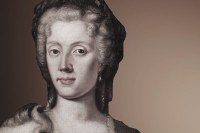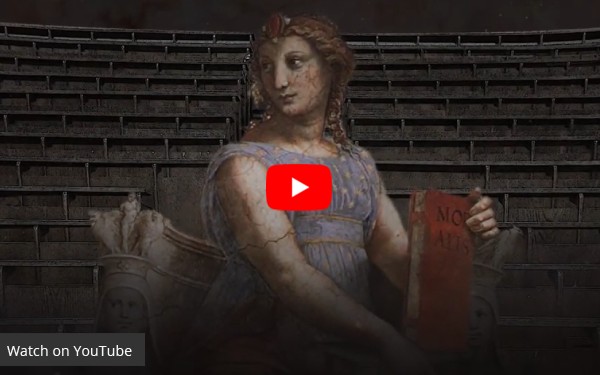The first woman to hold a university professorship, Laura Bassi was an extraordinary exception to the rule. Her training in and talent for science were such that the entire university used her in a targeted strategy for self-promotion. Reaching a compromise with the academic world, Bassi managed to defend her place and ultimately win a professorship in experimental physics thanks to her brilliance and not her gender.
 Laura Bassi was born in Bologna in 1711. The only daughter of the lawyer Giuseppe Bassi and Rosa Maria Cesari, both from the lower middle class, she was privately educated under the supervision of a distant relative, the priest Lorenzo Stegani. Stegani was then replaced by the family physician and anatomy professor Gaetano Tacconi.
Laura Bassi was born in Bologna in 1711. The only daughter of the lawyer Giuseppe Bassi and Rosa Maria Cesari, both from the lower middle class, she was privately educated under the supervision of a distant relative, the priest Lorenzo Stegani. Stegani was then replaced by the family physician and anatomy professor Gaetano Tacconi.
Tacconi persuaded her parents to promote their daughter’s learning socially, introducing her into the inner circles of Bologna. On one of these occasions, in 1731, Laura met the cardinal Prospero Lambertini (the future Benedict XIV) who, struck by her gifts, immediately set to work to ensure that the Senate grant her a degree.
This marked the beginning of Bassi’s annus mirabilis: 1732.
In March, the twenty-one-year-old was made an honorary member of the city’s science academy; in April, she presented her theses and took a degree in philosophy, also becoming an honorary member of the College of Philosophers; in June, after the discussion of additional theses, she was granted another university teaching qualification; in October, she was given an honorary post in natural philosophy and, in December, she held her first lecture at the Archiginnasio.
All of these events took place under the city spotlights, the hope being to use the extraordinary conferral of a university professorship to a woman to return Bologna to its place among the most avant-garde cities of Europe.
This was underpinned in part by exaltation of the city’s legendary medieval past, the university claiming that it was already accustomed to having the wives, sisters and daughters of distinguished professors as teachers.
This rebellious “feminist propaganda” in reality excluded Bassi from public teaching, with the exception of special occasions, and gave her an annual award of 500 lire in place of a salary like all of the other professors.
But the young scientist did not lose spirit and indeed continued to study and progress. Through Iacopo Bartolomeo Beccari, professor of experimental physics at the Istituto delle Scienze, she became familiar with the works of Newton, while she became proficient in mathematical analysis under the mathematician Gabriele Manfredi.
In spite of the praise, shameless gossip began to circulate among her colleagues and others, which she decided to placate by getting married. And so, in 1738, she wed the physician and professor of physics Giuseppe Veratti, who shared her interests and passions. The two had eight children, only five of whom survived infancy. One was their only daughter, Caterina, who died in a convent at just twenty years of age. It is revealing that Laura did not provide her with an advanced education.
In 1745, as soon as the Accademia benedettina was founded by Benedict XIV to boost the success of the Istituto delle Scienze, Bassi was made a member, although only as an extra (such that a place that was “due them” would not be “taken” from her male colleagues).
At that time, professors, required to respect rigid rules and teaching theories imposed by the Church when working at the university, found greater satisfaction in their research and lectures at Marsigli’s Istituto, which provided them with sophisticated laboratories, naturalistic and artistic galleries and a well-stocked, up-to-date library. Many of them also worked on a small scale out of their homes. One of the most celebrated cases of this was that of Bassi and her husband, their home being a place where she could truly teach, free from the restrictions imposed due to her gender. From 1749 until her death, the Bassi-Veratti laboratory was known and frequented by the greatest names in the city and beyond (Lazzaro Spallanzani, Alessandro Volta, Leopoldo M. Caldani, Felice Fontana, Giambattista Beccaria, Jean-Antoine Nollet), to the point that the Senate, while continuing to keep Bassi away from the university, causa sexus, increased her annual award several times.
Her fame and brilliance were rewarded in 1776, when the Senate finally granted her the post of professor of experimental physics at the Istituto delle Scienze.
Not even two years later, however, in 1778, the first female university professor in the world died, leaving her post once again to the usual men and quickly becoming merely a historical point of pride.
She was buried in the church of the Corpus Domini, where her sincere admirer, Luigi Galvani, was buried as well, ten years later.
After Bassi, very few women became professors at the University of Bologna (Clotilde Tambroni and Maria dalle Donne), perceived as a threat by their male colleagues in an institution like that of the university, which was built and developed on an obstinately misogynist foundation. With the arrival of Napoleon and the university reforms of 1802, the already faint, sporadic presence of women was completely wiped out, and it was not until the end of the century that it could begin to make its timid but definitive return.

